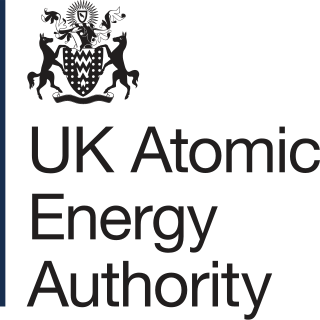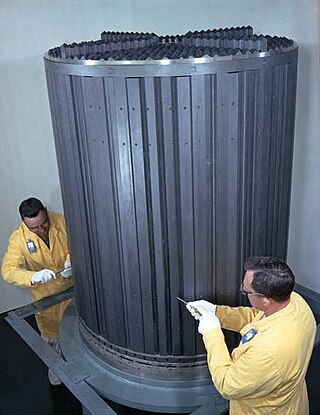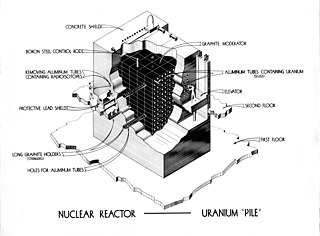Related Research Articles

The Baghdad Nuclear Research Facility adjacent to the Tuwaitha "Yellow Cake Factory" or Tuwaitha Nuclear Research Center contains the remains of nuclear reactors bombed by Iran in 1980, Israel in 1981 and the United States in 1991. It was used as a storage facility for spent reactor fuel and industrial and medical wastes. The radioactive material would not be useful for a fission bomb, but could be used in a dirty bomb. Following the 2003 invasion of Iraq, the facility was heavily looted by hundreds of Iraqis, though it is unclear what was taken.

The Atomic Energy Research Establishment (AERE) was the main centre for atomic energy research and development in the United Kingdom from 1946 to the 1990s. It was created, owned and funded by the British Government.

Magnox is a type of nuclear power / production reactor that was designed to run on natural uranium with graphite as the moderator and carbon dioxide gas as the heat exchange coolant. It belongs to the wider class of gas-cooled reactors. The name comes from the magnesium-aluminium alloy, used to clad the fuel rods inside the reactor. Like most other "Generation I nuclear reactors", the Magnox was designed with the dual purpose of producing electrical power and plutonium-239 for the nascent nuclear weapons programme in Britain. The name refers specifically to the United Kingdom design but is sometimes used generically to refer to any similar reactor.

The United Kingdom Atomic Energy Authority is a UK government research organisation responsible for the development of fusion energy. It is an executive non-departmental public body of the Department for Energy Security and Net Zero (DESNZ).

Dounreay is a small settlement and the site of two large nuclear establishments on the north coast of Caithness in the Highland area of Scotland. It is on the A836 road nine miles west of Thurso.

The High Flux Australian Reactor (HIFAR) was Australia's first nuclear reactor. It was built at the Australian Atomic Energy Commission Research Establishment at Lucas Heights, Sydney. The reactor was in operation between 1958 and 2007, when it was superseded by the Open-pool Australian lightwater reactor, also in Lucas Heights.
DIDO was a materials testing nuclear reactor at the Atomic Energy Research Establishment at Harwell, Oxfordshire in the United Kingdom. It used enriched uranium metal fuel, and heavy water as both neutron moderator and primary coolant. There was also a graphite neutron reflector surrounding the core. In the design phase, DIDO was known as AE334 after its engineering design number.

Chapelcross nuclear power station is a former Magnox nuclear power station undergoing decommissioning. It is located in Annan in Dumfries and Galloway in southwest Scotland, and was in operation from 1959 to 2004. It was the sister plant to the Calder Hall nuclear power station plant in Cumbria, England; both were commissioned and originally operated by the United Kingdom Atomic Energy Authority. The primary purpose of both plants was to produce weapons-grade plutonium for the UK's nuclear weapons programme, but they also generated electrical power for the National Grid. Later in the reactors' lifecycle, as the UK slowed the development of the nuclear deterrent as the cold war came to a close, power production became the primary goal of reactor operation.

Neutron activation is the process in which neutron radiation induces radioactivity in materials, and occurs when atomic nuclei capture free neutrons, becoming heavier and entering excited states. The excited nucleus decays immediately by emitting gamma rays, or particles such as beta particles, alpha particles, fission products, and neutrons. Thus, the process of neutron capture, even after any intermediate decay, often results in the formation of an unstable activation product. Such radioactive nuclei can exhibit half-lives ranging from small fractions of a second to many years.

Research reactors are nuclear fission-based nuclear reactors that serve primarily as a neutron source. They are also called non-power reactors, in contrast to power reactors that are used for electricity production, heat generation, or maritime propulsion.

The Reed Research Reactor (RRR) is a research nuclear reactor located on-campus at Reed College in Portland, Oregon. It is a pool-type TRIGA Mark I reactor, built by General Atomics in 1968 and operated since then under licence from the Nuclear Regulatory Commission. Maximum thermal output is 250 kW. The reactor has over 1,000 visitors each year and serves the Reed College departments of Physics and Chemistry, as well as other departments.

The Advanced Test Reactor (ATR) is a research reactor at the Idaho National Laboratory, located east of Arco, Idaho. This reactor was designed and is used to test nuclear fuels and materials to be used in power plants, naval propulsion, research and advanced reactors. It can operate at a maximum thermal power of 250 MW and has a "Four Leaf Clover" core design that allows for a variety of testing locations. The unique design allows for different neutron flux conditions in various locations. Six of the test locations allow an experiment to be isolated from the primary cooling system, providing its own environment for temperature, pressure, flow and chemistry, replicating the physical environment while accelerating the nuclear conditions.

Nuclear graphite is any grade of graphite, usually synthetic graphite, manufactured for use as a moderator or reflector within a nuclear reactor. Graphite is an important material for the construction of both historical and modern nuclear reactors, due to its extreme purity and ability to withstand extremely high temperature.

A graphite-moderated reactor is a nuclear reactor that uses carbon as a neutron moderator, which allows natural uranium to be used as nuclear fuel.

Iran's nuclear program is made up of a number of nuclear facilities, including nuclear reactors and various nuclear fuel cycle facilities.
ETRR-1 or ET-RR-1, is the first nuclear reactor in Egypt supplied by the USSR in 1958. The reactor is owned and operated by Egyptian Atomic Energy Authority (AEA) at the Nuclear Research Center in Inshas, 40–60 kilometres (25–37 mi) northeast of Cairo.
ETRR-2 or ET-RR-2, or is the second nuclear reactor in Egypt supplied by the Argentine company Investigacion Aplicada (INVAP) in 1992. The reactor is owned and operated by Egyptian Atomic Energy Authority (EAEA) at the Nuclear Research Center in Inshas, 60 kilometres (37 mi) northeast of Cairo.

The Windscale Piles were two air-cooled graphite-moderated nuclear reactors on the Windscale nuclear site in Cumberland on the north-west coast of England. The two reactors, referred to at the time as "piles", were built as part of the British post-war atomic bomb project and produced weapons-grade plutonium for use in nuclear weapons.

FiR 1 was Finland's first nuclear reactor. It was a research reactor that was located in the Otaniemi campus area in the city of Espoo. The TRIGA Mark II reactor had a thermal power of 250 kilowatts. It started operation in 1962, and it was permanently shut down in 2015. At first, the reactor was operated by Helsinki University of Technology (TKK), and since 1971 by VTT Technical Research Centre of Finland.
References
- 1 2 Bangash, M. Y. H. Structures for Nuclear Facilities. London: Springer, 2011. Print.
- ↑ Paul Mobbs."The Safety of the UKAEA Harwell Establishment and in particular the Safety of the Harwell Materials Testing Reactors".November/December, 1989. Web. 8 November 2014.< "Archived copy" (PDF). Archived from the original (PDF) on 10 November 2014. Retrieved 10 November 2014.
{{cite web}}: CS1 maint: archived copy as title (link)> - ↑ Kumar, Arvind S,. Gelles, Davis S. Effects of Radiation on Materials: 15th International Symposium, Philadelphia: ASTM. August 1992. Print.
- ↑ "Eyes' for Pluto Reactor." Journal of Electronics and Control 5.5 (1958): 439. Rpt. in Article CC:CCL. 5th ed. Vol. 5. N.p.: U of Central Florida, 1958. 439. TK7800 .J6 Bound. Web. 4 Nov. 2014.
- ↑ IAEA "Multipurpose Research Reactors" Symposium. July 1988. Web 30 October 2014.<http://www.iaea.org/inis/collection/NCLCollectionStore/_Public/20/019/20019411.pdf>
- 1 2 UKAEA."DIDO and PLUTO Material Testing Reactors." Harwell Project Profiles (n.d.). Web. 4 Nov. 2014 < http://www.research-sites.com/UserFiles/File/Archive/Project%20Information/Harwell-dido-pluto.pdf Archived 24 September 2015 at the Wayback Machine >
- ↑ Lewis H. G. "International Approaches To Decommissioning Nuclear Facilities". Health and Safety Executive, 2000. Web. 8 November 2014 <http://www.hse.gov.uk/research/nuclear/decommission.pdf Archived 4 March 2016 at the Wayback Machine >